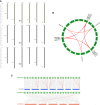Uncovering the role of wheat magnesium transporter family genes in abiotic responses
- PMID: 36844102
- PMCID: PMC9948656
- DOI: 10.3389/fpls.2023.1078299
Uncovering the role of wheat magnesium transporter family genes in abiotic responses
Abstract
Background: The CorA / MGT / MRS2 family proteins are an important group of magnesium transporter proteins that maintain magnesium ion homeostasis in plant cells. However, little is known about the MGT functions in wheat.
Methods: The known MGT sequences were used as queries to BlastP against wheat genome IWGSC RefSeq v2.1 assembly (E-value <10-5). Chromosome localization information for each TaMGT gene was obtained from the GFF3 file of the wheat genome data (IWGSCv2.1).The sequence of 1500 bp upstream of the TaMGT genes was extracted from the wheat genome data. The cis-elements were analyzed using PlantCARE online tool.
Result: A total of 24 MGT genes were identified on 18 chromosomes of wheat. After functional domain analysis, only TaMGT1A, TaMGT1B, and TaMGT1D had GMN mutations to AMN, while all the other genes had conserved GMN tripeptide motifs. Expression profiling showed that the TaMGT genes were differentially expressed under different stresses and at different growth and development stages. The expression levels of TaMGT4B and TaMGT4A were significantly up-regulated in cold damage. In addition, qRT-PCR results also confirmed that these TaMGT genes are involved in the wheat abiotic stress responses.
Conclusion: In conclusion, The results of our research provide a theoretical basis for further research on the function of TaMGT gene family in wheat.
Keywords: TaMGT; abiotic stresses; climate-resilience; fluorescence quantitative PCR; gene expression; gene structure.
Copyright © 2023 Tang, Yang, Li, Shuai, Chen, Ma and Lü.
Conflict of interest statement
The authors declare that the research was conducted in the absence of any commercial or financial relationships that could be construed as a potential conflict of interest.
Figures







Similar articles
-
Identification, and Functional and Expression Analyses of the CorA/MRS2/MGT-Type Magnesium Transporter Family in Maize.Plant Cell Physiol. 2016 Jun;57(6):1153-68. doi: 10.1093/pcp/pcw064. Epub 2016 Apr 15. Plant Cell Physiol. 2016. PMID: 27084594
-
The maize CorA/MRS2/MGT-type Mg transporter, ZmMGT10, responses to magnesium deficiency and confers low magnesium tolerance in transgenic Arabidopsis.Plant Mol Biol. 2017 Oct;95(3):269-278. doi: 10.1007/s11103-017-0645-1. Epub 2017 Sep 4. Plant Mol Biol. 2017. PMID: 28871377
-
Genome-wide analysis of wheat DNA-binding with one finger (Dof) transcription factor genes: evolutionary characteristics and diverse abiotic stress responses.BMC Genomics. 2020 Apr 3;21(1):276. doi: 10.1186/s12864-020-6691-0. BMC Genomics. 2020. PMID: 32245398 Free PMC article.
-
Expression and functional analysis of the CorA-MRS2-ALR-type magnesium transporter family in rice.Plant Cell Physiol. 2013 Oct;54(10):1673-83. doi: 10.1093/pcp/pct112. Epub 2013 Aug 7. Plant Cell Physiol. 2013. PMID: 23926064
-
Molecular identification of the magnesium transport gene family in Brassica napus.Plant Physiol Biochem. 2019 Mar;136:204-214. doi: 10.1016/j.plaphy.2019.01.017. Epub 2019 Jan 17. Plant Physiol Biochem. 2019. PMID: 30690277 Review.
Cited by
-
An Antarctic lichen isolate (Cladonia borealis) genome reveals potential adaptation to extreme environments.Sci Rep. 2024 Jan 16;14(1):1342. doi: 10.1038/s41598-024-51895-x. Sci Rep. 2024. PMID: 38228797 Free PMC article.
-
Effect of biostimulants combined with fertilization on yield and nutritional value of wheat crops.BMC Plant Biol. 2025 May 31;25(1):736. doi: 10.1186/s12870-025-06804-3. BMC Plant Biol. 2025. PMID: 40450219 Free PMC article.
-
Novel resistance loci for quantitative resistance to Septoria tritici blotch in Asian wheat (Triticum aestivum) via genome-wide association study.BMC Plant Biol. 2024 Sep 9;24(1):846. doi: 10.1186/s12870-024-05547-x. BMC Plant Biol. 2024. PMID: 39251916 Free PMC article.
-
An Agrobacterium-Mediated Transient Expression Method for Functional Assay of Genes Promoting Disease in Monocots.Int J Mol Sci. 2023 Apr 21;24(8):7636. doi: 10.3390/ijms24087636. Int J Mol Sci. 2023. PMID: 37108797 Free PMC article.
-
Genome-wide identification of MGT gene family in soybean (Glycine max) and their expression analyses under magnesium stress conditions.BMC Plant Biol. 2025 Jan 22;25(1):83. doi: 10.1186/s12870-024-05985-7. BMC Plant Biol. 2025. PMID: 39838318 Free PMC article.
References
-
- Banerjee J., Sahoo D. K., Dey N., Houtz R. L., Maiti I. B. (2013). An intergenic region shared by At4g35985 and At4g35987 in arabidopsis thaliana is a tissue specific and stress inducible bidirectional promoter analyzed in transgenic arabidopsis and tobacco plants. PLos One 8, e79622. doi: 10.1371/journal.pone.0079622 - DOI - PMC - PubMed
-
- Cakmak I., Yazici A. M. (2010). Magnesium: a forgotten element in crop production. Better. Crops 94, 23–25.
LinkOut - more resources
Full Text Sources

